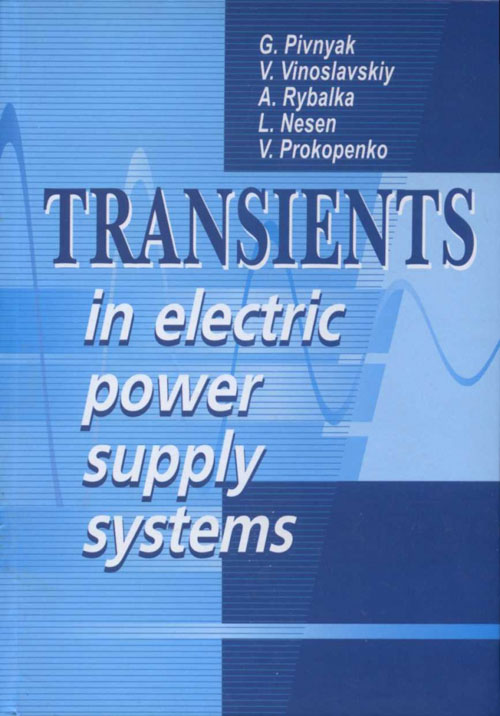| INTRODUCTION |
9 |
PART 1 ELECTROMAGNETIC TRANSIENTS |
|
CHAPTER 1. |
GENERAL INFORMATION ABOUT TRANSIENTS |
14 |
| |
1.1. Kinds, reasons and consequences of short circuits |
15 |
| |
1.2. Purpose of electromagnetic transients
calculation, design conditions |
18 |
| |
1.3. Basic regularities of short circuit
currents calculation |
20 |
| |
1.4. Design circuit of electric power supply
system and its components description |
22 |
| |
1.5. Equivalent circuit and methods of
its parameters calculation |
25 |
| |
1.6. Transformations of equivalent circuits
|
32 |
| |
1.7. Application of approximate reduction
in per unit |
36 |
| |
Test questions |
38 |
| |
Topics for essay |
38 |
CHAPTER 2. |
TRANSIENTS AT THREE-PHASE SHORT CIRCUITS |
39 |
| |
2.1. Short circuit in radial network without transformer coupling |
40 |
| |
2.2. Short circuit on generator's terminals |
48 |
| |
2.3. Short circuit at remote points of
electric supply network |
52 |
| |
2.4. Initial value of periodic component
of short circuit current |
54 |
| |
2.5. Periodic component of short circuit
current for any instant of time |
57 |
| |
2.6. Short circuit current of emergency
steady state |
59 |
| |
Test questions |
61 |
| |
Topics for essay |
61 |
CHAPTER 3. |
EVALUATION OF TRANSIENTS UNDER THREE-PHASE SHORT CIRCUITS |
62 |
| |
3.1. Basic statements |
63 |
| |
3.2. Use of short circuit periodical component
diagrams in network with one source |
64 |
| |
3.3. Use of short circuit current periodical
component diagrams in a network with several sources |
70 |
| |
3.4. Calculation of short circuit current
periodical component for any time instant by rectified characteristics method |
72 |
| |
3.5. Short circuit currents calculation
on the principle of superposition |
79 |
| |
3.6. Calculation of short circuit current
components stipulated by load centers |
81 |
| |
3.7. Calculation of short circuit currents
in electrical installations with voltage up to 1 kV |
91 |
| |
3.8. Computer-aided calculation of short
circuit current |
107 |
| |
Test questions |
111 |
| |
Topics for essay |
111 |
CHAPTER 4. |
KEY ITEMS CONCERNING ANALYSIS OF TRANSIENTS UNDER ASYMMETRY IN THREE-PHASE
NETWORK |
112 |
| |
4.1. General information |
113 |
| |
4.2. Generation of higher harmonics by
synchronous generator |
113 |
| |
4.3. Method of symmetric components |
116 |
| |
4.4. Relationships between symmetrical
components of current and voltage |
119 |
| |
4.5. Resistances of negative and zero sequences
of circuit elements |
121 |
| |
4.6. Drawing up equivalent circuits for
symmetrical components |
138 |
| |
4.7. Resulting electromotive forces and
impedances of equivalent circuits for separate sequences |
141 |
| |
Test questions |
142 |
| |
Topics for essay |
143 |
CHAPTER 5. |
LATERAL ASYMMETRY. |
144 |
| |
5.1. Starting statements |
145 |
| |
5.2. Single-phase short circuit |
147 |
| |
5.3. Two-phase short circuit |
149 |
| |
5.4. Two-phase short circuit to ground
|
152 |
| |
5.5. Account of contact resistance at the
point of short circuit |
154 |
| |
5.6. Equivalence rule for the current of
positive sequence |
156 |
| |
5.7. Integrated equivalent circuits
|
159 |
| |
5.8. Comparison of currents at different
short circuits |
162 |
| |
5.9. Symmetrical current and voltage components
transformation |
165 |
| |
5.10. Methods of asymmetrical short circuit
calculation |
172 |
| |
Test questions |
177 |
| |
Topics for essay |
177 |
CHAPTER 6. |
LONGITUDINAL ASYMMETRY AND COMPLEX FAULTS |
178 |
| |
6.1. General statements |
179 |
| |
6.2. Open-phase fault in three-phase network
|
180 |
| |
6.3. Two-phases open fault |
182 |
| |
6.4. Connection of unequal resistors in
network phases |
184 |
| |
6.5. Double ground connection |
187 |
| |
6.6. Single-phase short circuit with simultaneous
open-phase fault |
193 |
| |
Test questions |
196 |
| |
Topics for essay |
196 |
CHAPTER 7. |
TRANSIENTS UNDER SPECIFIC CONDITIONS |
197 |
| |
7.1. Short circuits in the network of external electric power supply
|
198 |
| |
7.2. Short-circuit to ground in the network
with insulated neutral |
200 |
| |
7.3. Short circuits in the networks of
increased frequency |
205 |
| |
7.4. Transients stipulated by peculiarities
of production process |
205 |
| |
7.5. Processes taking place under capacitor
banks commutation |
208 |
| |
7.6. Short circuits in DC lines |
210 |
| |
Test questions |
215 |
| |
Topics for essay |
215 |
CHAPTER 8. |
LEVELS OF CURRENTS AND POWER OF SHORT CIRCUIT |
216 |
| |
8.1. Quality of electromagnetic transients |
217 |
| |
8.2. Ways of short circuit currents limiting
|
219 |
| |
8.3. Use of technical facilities for short
circuit current level optimization |
225 |
| |
8.4. Short circuit current level optimization
|
236 |
| |
8.5. Short circuit currents levels coordination
|
238 |
| |
Test questions |
240 |
| |
Topics for essay |
240 |
PART 2 ELECTROMECHANICAL TRANSIENTS |
|
CHAPTER 9. |
ANALYSIS TASKS AND ELECTROMECHANICAL PROCESSES CHARACTERIZATION |
241 |
| |
9.1. Background of the problem |
242 |
| |
9.2. Consequences of short-time failures
in power supply |
243 |
| |
9.3. Conditions of power supply system
operation mode maintenance |
244 |
| |
9.4. Mathematical models of power supply
system components |
245 |
| |
9.5. Modeling of industrial enterprise
electric load for power supply system stability analysis |
251 |
| |
Test questions |
255 |
| |
Topics for essay |
255 |
CHAPTER 10. |
METHODS OF STATIC STABILITY CALCULATION |
256 |
| |
10.1. Static stability criteria |
257 |
| |
10.2. Application of practical static stability
criteria |
261 |
| |
10.3. Analysis of static stability by method
of small oscillations |
270 |
| |
10.4. Account of automatic excitation control
in static stability calculations |
278 |
| |
Test questions |
287 |
| |
Topics for essay |
287 |
CHAPTER 11. |
STABILITY OF ELECTRIC POWER SUPPLY SYSTEM OPERATION UNDER LARGE DISTURBANCES |
288 |
| |
11.1. Dynamic stability of operation |
289 |
| |
11.2. Simplified methods of dynamic operation
stability evaluation |
292 |
| |
11.3. Estimation of dynamic operation stability
of complex electric power system |
296 |
| |
11.4. Estimation of dynamic stability of
operation with account of generators excitation control |
301 |
| |
11.5. Resulting operation stability |
305 |
| |
11.6. Estimation of resulting operation
stability |
307 |
| |
11.7. Computation facilities application
to study operation stability |
311 |
| |
Test questions |
312 |
| |
Topics for essay |
312 |
CHAPTER 12. |
STABILITY OF LOAD NODES OPERATION UNDER SMALL DISTURBANCES |
313 |
| |
12.1. Starting positions |
314 |
| |
12.2. Operation stability of induction
and synchronous motors analysis |
317 |
| |
12.3. Account of influence of electric
line parameters on stability of load node operation |
319 |
| |
12.4. Influence of reactive power compensation
on stability of load node operation |
324 |
| |
12.5. Use of load static characteristics
for calculations of complex load node operation stability |
329 |
| |
Test questions |
333 |
| |
Topics for essay |
333 |
CHAPTER 13. |
STABILITY OF LOAD NODE OPERATION AT LARGE DISTURBANCES |
334 |
| |
13.1. Typical causes of large disturbances occurrence in load nodes |
335 |
| |
13.2. General set of equations for electromechanical
transients in an induction motor |
336 |
| |
13.3. Analysis of large disturbance having
the form of three-phase fault on the terminals of an induction motor |
338 |
| |
13.4. Analysis of large disturbance having
the form of load surge on induction motor |
340 |
| |
13.5. Starting induction motors |
343 |
| |
13.6. Self-excitation of induction motors
while starting with series capacitive compensation at the network |
345 |
| |
13.7. Self-starting induction motors |
347 |
| |
13.8. Equations of electromechanical transients
in synchronous motor |
350 |
| |
13.9. Analysis of large disturbance arising
in the form of three-phase fault on terminals of a synchronous motor................................. |
352 |
| |
13.10. Load surge on synchronous motor |
353 |
| |
13.11. Starting synchronous motors |
356 |
| |
13.12. Self-starting synchronous motors |
358 |
| |
13.13. Electromechanical transients in
complex load node |
360 |
| |
Test questions |
366 |
| |
Topics for essay |
367 |
CHAPTER 14. |
ENSURING OPERATION STABILITY IN POWER SUPPLY SYSTEMS |
368 |
| |
14.1. General statements |
369 |
| |
14.2. Ensuring power supply system operation
stability in project stage |
369 |
| |
14.3. Use of control means at electric
power stations in operating conditions |
373 |
| |
14.4. Use of protection devices and system
automatic equipment |
374 |
| |
Test questions |
378 |
| |
Topics for essay |
378 |
CHAPTER 15. |
MONITORING AND DIAGNOSTICS OF EMERGENCY OPERATION MODES |
379 |
| |
15.1. Initial statements |
380 |
| |
15.2. Development of software for circuit
diagrams and electric power supply system operation monitoring |
382 |
| |
15.3. Program complex for distributive
networks control |
384 |
| |
15.4. Monitoring of transients |
389 |
| |
15.5. Development of methods of short circuit
points identification in high-voltage power transmission lines |
390 |
REFERENCES |
392 |
GLOSSARY |
395 |



